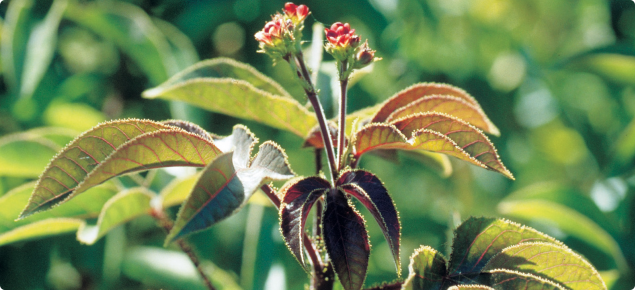Form: shrub — perennial
Status: present in WA
Bellyache bush is native of tropical Central and South America and Caribbean islands.This species has a widespread but scattered distribution throughout northern Australia. It is most common in the northern parts of Queensland, the Northern Territory and Western Australia, but is also present in central and south-eastern Queensland and in other parts of the Northern Territory. It is a Weed of National Significance (WoNS).
Appearance
Erect shrub or small tree to four metres high, deciduous in dry conditions.
Stems: Hairy, non-woody.
Leaves: Initially purplish but green when mature, sticky, 5.5–14 centimetres long, 7.5–12.5 centimetres wide, rounded in outline, leaf stalks 4.5–11.5 centimetres long. Leaf margins and leaf stalks with gland-tipped hairs; leaves alternate, margins deeply three to five lobed.
Flowers: Flower head branched. Flowers about one centimetre across. Petals purple with yellow base. Flowers most of year but chiefly late summer and autumn.
Fruit: An oblong lobed capsule to 1.2 centimetres long, capsule, initially green, ripens dark brown. Mostly three or four seeded.
Seeds: Brown seeds to 0.8 ccentimetres long, slightly mottled.
Roots: Fleshy and tuberous.
Agriculture and economic impact
Bellyache bush invades disturbed areas and waterways. The shallow root system and canopy cover of bellyache bush restricts growth of other plants, often outcompeting native vegetation and reducing pasture growth, rendering floodplain pastures unproductive. Dense infestations may occur on river flats and other areas of good loamy soil, reducing biodiversity and interfering with mustering on grazing properties.
It is also poisonous to livestock. Although unpalatable, accidental ingestion of bellyache bush seeds commonly occurs when livestock browse on dry grass and fallen leaf litter during the dry season.
Declared pest category
The Western Australian Organism List (WAOL) contains information on the area(s) in which this pest is declared and the control and keeping categories to which it has been assigned in Western Australia (WA). Use the links on this page to reach bellyache bush in WAOL.
Requirements for land owners/occupiers and other persons
Requirements for land owners/occupiers and other persons if this pest is found can be sourced through the declared plant requirements link.
Search > detect > report
| MyPestGuide™ Reporter | Pest and Disease Information Service (PaDIS) |
Control method
Control methods for this declared plant can be found through the bellyache bush control link.
Further details
Further details on this declared plant can be found in the link physic nut and bellyache bush: what you should know.

